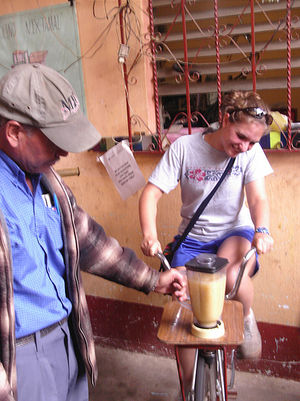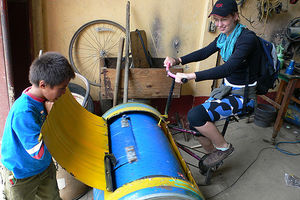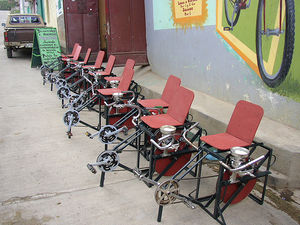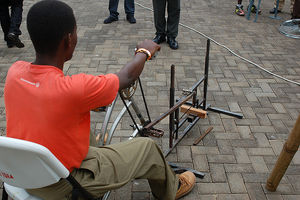Bicycle technology
Bicycle technology ("biketech") is the extension of the basic components of bicycle construction to a larger field of uses. Power delivered to pedals (by arms, legs, or other source of motion), transmitted by bicycle chains, drive cables, and/or bicycle gears is applied to power machines or generate electricity. The supplied motion may be used for transport, pumping water, vacuum pumping, seed winnowing, and so on. Thus, without the infrastructure for electricity or internal combustion, the motive power of human beings can be multiplied and extended to alleviate tedious tasks in agriculture. When all aspects are considered, this technology is probably much less expensive than the current electric way of doing things (build-out for electric infrastructure, mining copper for electric motors, burning fossil hydrocarbons in power plants causing climate disruption etc.).
Set of Components
The set of components utilized in bicycle technology is the simplest set that will enable a human to power a broad range of mechanized devices. This set of components is includes but is not limited to:
- simple gears
- chain links
- crank arms (from pedal to gear)
- bearings
- braided wire (for lever based controls)
- levers (for lever based control)
- pulleys/wheel frames
- drive belts
- metal tubes (welded to make frames)
All of these (except drive belts) are castable or extrudable if a group has metal working technology. However, due to the fact that these parts rarely physically fail and are widely interchangeable, a small casting/extruding operation would likely supply a large population. The commonness of certain larger units, such as forks for holding wheels/pulleys, increases the reusability of parts. Individual devices would require additional components, such as for pumps, blowers, or threshers, which could be manufactured with similar infrastructure.
Maya Pedal
Maya Pedal is a group in Guatemala employing bicycle technology for a large variety of uses amongst agrarian and city folks. The organization has extensive open source downloadable design information on their website. Applications with proven implementation:
- water (rope) pump
- corn grinder
- nut sheller
- blender
- microconcrete vibrator for roofing tiles
- coffee depulper
- metal sharpener
- washing machine
- 12V electricity generator (prototype exists, but there are no plans on the site. You could use the same generator mechanism as open-source wind turbines, but get rid of the turbine blades, and stick the axle of the bike in there instead.
- soil plow/till/hoe
- wood saw
"The Human Powered Home"
This is the title of a book by Tamara Dean. To name just a few of the pedal-powererd examples compiled in this fantastic book:
- cider press
- apple grinder
- “juicycle”
- lawn mower
- snow plow
- laundry spinner
- tool sharpener
- gas pump
- electrical generator
The book also has a list of "late 19th century human powered devices":
- blocking machine (for hat making)
- boring machine
- broom winder (broom making machine)
- cigar maker (or former)
- circular saw
- dentist drill
- dragsaw
- drill press
- former (sharpener)
- graphophone (dictating machine)
- harvester (treadmill type)
- hook and eye maker
- knitting machine
- milking machine
- miter saw
- mortising machine
- printing press
- punch machine
- rip saw (table saw)
- riveting machine
- screw-cutting lathe
- scroll saw (jigsaw)
- seed cleaner
- sewing machine
- spinning wheel
- stave cutting machine
- thresher
- tip stretcher (for hat making)
- tool sharpener
- typewriter
- vegetable bundler (or buncher, for asparagus or celery)
- weaving loom
- wood lathe
David Butcher designed a pedal-powered generator. Plans for sale here.
Product Ecology and more Ideas
- metallurgy and digital fabrication are needed to manufacture the components
- compressed air and hydraulic motors as an alternative (perhaps preferred) way to power these devices - is it possible to design a single power interface to use whatever energy is available ??? (i.e. small hydro, wind, biomass, steam engine, human or animal muscle, etc. This would be a big achievement.
- possibility of hydraulic transmission rather than chain. Some people, such as this guy, are using this technology to create hydraulic bicycles.
- idea: wheeled construction shovel
Links
- Book by Tamara Dean: "The Human-Powered Home"
- Itech at UC davis offers plans for many useful devices which could be bicycle powered.
- Appropedia Category on Pedal Power - contains open-source plans for a few pedal-powered generators
- Christoph Thetard: "Kitchen Machines"
- MIT D-Lab "Cycle Ventures"



